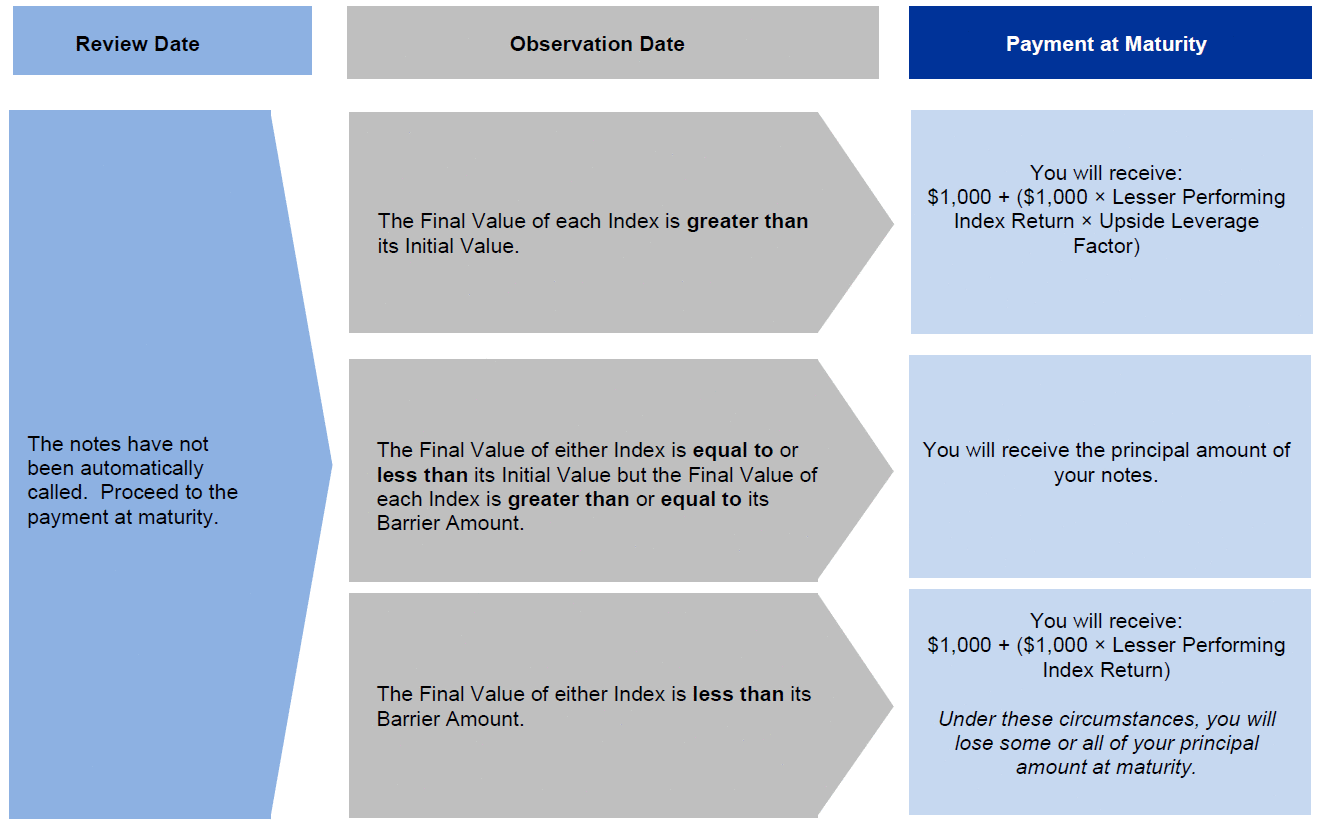How the Notes Work
Upside Scenario If Automatic Call:
If the closing level of each Index on the Review Date is greater than or equal to its Call Value, the notes will be automatically called and investors will receive on the Call Settlement Date the $1,000 principal amount plus the Call Premium Amount of at least $91.00. No further payments will be made on the notes.
●Assuming a hypothetical Call Premium Amount of $91.00, if the closing level of the lesser performing of the Indices increases 10.00% as of the Review Date, the notes will be automatically called and investors will receive a return equal to 9.10%, or $1,091.00 per $1,000 principal amount note.
Upside Scenario If No Automatic Call:
If the notes have not been automatically called and the Final Value of each Index is greater than its Initial Value, investors will receive at maturity the $1,000 principal amount plus a return equal to the Lesser Performing Index Return times the Upside Leverage Factor of 1.50.
●If the notes have not been automatically called and the closing level of the Lesser Performing Index increases 10.00%, investors will receive at maturity a return equal to 15.00%, or $1,150.00 per $1,000 principal amount note.
Par Scenario:
If the notes have not been automatically called and the Final Value of either Index is equal to or less than its Initial Value but the Final Value of each Index is greater than or equal to its Barrier Amount of 70.00% of its Initial Value, investors will receive at maturity the principal amount of their notes.
Downside Scenario:
If the notes have not been automatically called and the Final Value of either Index is less than its Barrier Amount of 70.00% of its Initial Value, investors will lose 1% of the principal amount of their notes for every 1% that the Final Value of the Lesser Performing Index is less than its Initial Value.
●For example, if the notes have not been automatically called and the closing level of the Lesser Performing Index declines 40.00%, investors will lose 40.00% of their principal amount and receive only $600.00 per $1,000 principal amount note at maturity.
The hypothetical returns and hypothetical payments on the notes shown above apply only if you hold the notes for their entire term or until automatically called. These hypotheticals do not reflect the fees or expenses that would be associated with any sale in the secondary market. If these fees and expenses were included, the hypothetical returns and hypothetical payments shown above would likely be lower.
Selected Risk Considerations
An investment in the notes involves significant risks. These risks are explained in more detail in the “Risk Factors” sections of the accompanying prospectus supplement and product supplement and in Annex A to the accompanying prospectus addendum.
●YOUR INVESTMENT IN THE NOTES MAY RESULT IN A LOSS —
The notes do not guarantee any return of principal. If the notes have not been automatically called and the Final Value of either Index is less than its Barrier Amount, you will lose 1% of the principal amount of your notes for every 1% that the Final Value of the Lesser Performing Index is less than its Initial Value. Accordingly, under these circumstances, you will lose more than 30.00% of your principal amount at maturity and could lose all of your principal amount at maturity.
●CREDIT RISKS OF JPMORGAN FINANCIAL AND JPMORGAN CHASE & CO. —
Investors are dependent on our and JPMorgan Chase & Co.’s ability to pay all amounts due on the notes. Any actual or potential change in our or JPMorgan Chase & Co.’s creditworthiness or credit spreads, as determined by the market for taking that credit risk, is likely to adversely affect the value of the notes. If we and JPMorgan Chase & Co. were to default on our payment obligations, you may not receive any amounts owed to you under the notes and you could lose your entire investment.
●AS A FINANCE SUBSIDIARY, JPMORGAN FINANCIAL HAS NO INDEPENDENT OPERATIONS AND HAS LIMITED ASSETS —
As a finance subsidiary of JPMorgan Chase & Co., we have no independent operations beyond the issuance and administration of our securities and the collection of intercompany obligations. Aside from the initial capital contribution from JPMorgan Chase & Co., substantially all of our assets relate to obligations of JPMorgan Chase & Co. to make payments under loans made by us to JPMorgan Chase & Co. or under other intercompany agreements. As a result, we are dependent upon payments from JPMorgan Chase & Co. to meet our obligations under the notes. We are not a key operating subsidiary of JPMorgan Chase & Co. and in a bankruptcy or resolution of JPMorgan Chase & Co. we are not expected to have sufficient resources to meet our obligations in respect of the notes as they come due. If JPMorgan Chase & Co. does not make payments to us and we are unable to make payments on the notes, you may have to seek payment under the related guarantee by JPMorgan Chase & Co., and that guarantee will rank pari passu with all other unsecured and unsubordinated obligations of JPMorgan Chase & Co. For more information, see the accompanying prospectus addendum.





